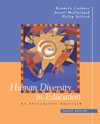 |  Human Diversity in Education: An Integrative Approach, 4/e Kenneth H. Cushner,
Kent State University, Kent
Averil McClelland,
Kent State University, Kent
Philip Safford,
Case Western Reserve University
Proven FeaturesTwo-Part Organization.
Part I provides the background to the current multicultural education movement, explains how cultural differences develop in groups and individuals, and how individuals with different cultural identities go through the same adjustment process when confronted with cross-cultural situations. Part II then examines what teachers can do to make their multicultural classrooms into effective learning communities; that is, into classrooms that are collaborative, inclusive, developmentally appropriate, globally oriented, and religiously pluralistic. Historical background of multicultural education is embedded throughout these chapters.Comprehensive Coverage of Diversity.
The text examines multiple forms of diversity including religious, social class and status, sexual orientation, the ability/disability continuum, etc. in order to provide students will a full understanding of their future students’ diversities.Inclusive Approach.
Human Diversity in Education applies “multicultural” to all students – not just minority groups.Focus on Individuals. Rather than focusing on groups, the authors have chosen to focus on intercultural interactions between individuals. There may very well be more diversity within a group than between groups, and students should come to realize that diversity acts on many levels, even within homogeneous groups.
|
|



 2003 McGraw-Hill Higher Education
2003 McGraw-Hill Higher Education